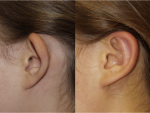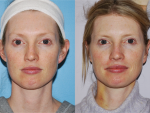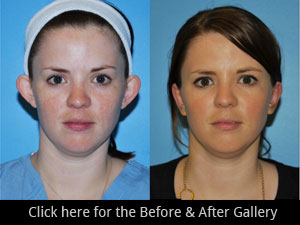What is ear pinning Surgery?
Ear pinning surgery, or Otoplasty, is a procedure to correct protruding ears. It involves reducing the size of the ear cartilage and securing it closer to the head. The surgery can be done on children or adults. Ear pinning surgery aims to create a more natural-looking ear and improve self-confidence. The results of the surgery are usually permanent.
Overly protruding ears or “lop ears” can be a source of teasing and self-confidence problems for children and adults. Through a simple operation, called otoplasty (or ear pinning), the shape and position of the ear can be modified to create a normal appearance. Although otoplasty is commonly performed on children in the pre-school or early school-age years, the procedure can provide significant benefit to adults with similar problems.
What Are the Types of Ear Pinning Surgery?
Understanding the various techniques available for ear pinning is crucial when considering this option. The primary methods include:
Suture Technique
This approach uses stitches to modify the ear cartilage, effectively bringing ears closer to the head. The suture technique is minimally invasive and typically results in minimal scarring, making it a favored option among patients.
Abrasion Technique
In the abrasion technique, a small section of cartilage is removed to create the desired ear shape. This method can be particularly effective for individuals with notable protrusion. The surgeon will evaluate your ear’s anatomy to determine the best approach for a natural-looking result.
Combined Technique
The combined technique employs a blend of suture and abrasion methods to optimize results. This personalized approach allows for a solution that addresses the specific needs of each patient. During your consultation meeting, a professional plastic surgeon will provide guidance on the most appropriate technique.
The Benefits of Ear Pinning Surgery
Choosing ear surgery offers several benefits, such as:
Enhanced Facial Aesthetics
Otoplasty can significantly improve facial appearance by addressing protrusion. A more proportionate ear shape allows individuals to feel more confident in their looks. Patients frequently experience increased comfort with their self-image when their ear structure is balanced.
Long-lasting Results
Unlike temporary cosmetic solutions, otoplasty procedures provide lasting results, enabling you to enjoy a harmonious look for years. With the right otoplasty surgeon, the results can be permanent. This procedure typically yields lifelong changes to ear shape, allowing patients to reap the benefits for an extended period without further surgeries.
Increased Self-Esteem
Addressing issues like the appearance of scars or asymmetry can lead to a notable boost in self-esteem. Many patients feel more comfortable and self-assured in social situations after cosmetic surgery. For numerous individuals, undergoing this surgery marks a significant moment in their lives, allowing them to embrace their appearance wholeheartedly.
Minimal Recovery Time
Otoplasty is frequently performed as an outpatient procedure, meaning patients can return home on the same day. The recovery period is generally shorter than many other cosmetic surgeries, making it a highly appealing choice for those with busy schedules. Most patients can resume their normal activities within a week or two, depending on their healing journey and the specific techniques utilized.
Who is A Good Candidate for Ear Pinning Surgery?
Individuals aiming to improve the appearance of their ears are often suitable for ear pinning. The ideal candidates for this procedure include:
- Children and Adolescents: Young patients who experience bullying or feel self-conscious about their ear shape can significantly benefit from the procedure. The surgery is typically performed once the ears reach full size, usually around ages five or six.
- Adults: Adults desiring to correct ear deformities or improve their balanced appearance can also be great candidates. Many choose to undergo ear correction surgery to address developed concerns over time.
During your consultation with board-certified plastic surgeons, you will review your health history and aesthetic aspirations to determine your suitability for this outpatient procedure. This dialogue is crucial for ensuring realistic expectations and a comprehensive understanding of the procedure.
How to Prepare For an Ear Pinning Surgery
Effective preparation is key to ensuring a smooth surgical experience. Here are the steps to take:
Consult Your Surgeon
During the initial consultation, discuss any medications you currently take and your medical history. Your otoplasty surgeon will offer specific guidance to follow leading up to the surgery. Being transparent about past surgeries or health issues is vital, as this information can significantly influence the procedure.
Plan for Recovery
Arranging for assistance during the recovery period will help facilitate a smoother healing process. Ensure you have a comfortable recovery environment, as each patient’s complete recovery time varies. Stock up on essentials like ice packs and loose clothing to promote healing.
The Ear Pinning Surgery Recovery Process
The ear pinning recovery process typically includes the following:
Immediate Post-Operative Care
After the surgery, you might experience swelling and discomfort, which can be effectively managed with prescribed medications. Scheduling a follow-up visit with your surgeon is essential to verify that healing is progressing correctly and avoid activities that could strain your ears, such as intense exercise, for a specified duration.
Long-Term Recovery
Ear pinning recovery usually lasts several weeks. During this time, patients should anticipate a gradual reduction in swelling and an improvement in ear shape. Adhering to all post-operative guidelines is essential for a successful recovery. Most individuals can return to daily activities within one to two weeks, although healing may take several months.
How much does Ear Pinning cost?
Otoplasty surgery costs can range from $3,000 to $6,000 depending on the surgeon’s fee, the anesthesia fee, and other related expenses.
How Dr. Sidle Performs Ear Pinning Surgery?
Dr. Sidle’s incision for the procedure is hidden behind the ear. The shape of the cartilage is changed through cartilage reshaping and the placement of sutures. After surgery, a small dressing is maintained for a few days. Swelling, bruising, and discomfort are typically mild and short-lived.
Why Prefer Dr. Sidle For Ear Pinning Surgery?
Experience Matters. As a board certified Facial Plastic Surgeon at Northwestern with expertise in the face and neck, Dr. Sidle can provide you with an individualized plan to achieve your goals of a more youthful face. Call our office for a one-on-one consultation.
Otoplasty (Ear Pinning Surgery) FAQs
Otoplasty surgery is usually performed by a qualified plastic surgeon. The surgeon makes a small incision behind the ear and removes some excess skin and cartilage. The surgeon then shapes the cartilage and closes the incision with stitches.
The surgeon makes a small incision in the back of the ear and then reshapes the cartilage to create a more aesthetically pleasing shape. Sutures hold the new shape in place, and the ears are typically bandaged following surgery. The procedure usually takes 1-2 hours to complete, depending on the extent of work that needs to be done.
Yes, Otoplasty is a safe and common surgery performed to correct protruding ears, usually in children, but it can also be done in adults. There are risks associated with any surgery, some of the potential risks in Otoplasty include bleeding, infection, and scarring. Most people experience excellent results from this procedure and are very happy with the outcome.
Full healing takes about six weeks, but you will likely feel better sooner than that. Most of the swelling and bruising should subside within the first week or two, but it may take a little longer for the incisions to fully heal. You must avoid strenuous activity for at least six weeks and avoid sun exposure until the scars have healed.
Most people report significant relief from the pain within 24 to 48 hours after surgery. However, some amount of soreness and discomfort is to be expected for several days following the procedure. Swelling may also persist for a week or two. It is important to follow your doctor’s post-care instructions carefully to ensure a speedy and safe recovery.
Insurance plans do not typically cover cosmetic procedures such as Otoplasty. However, some insurance companies may offer coverage for the procedure under certain circumstances (e.g., if the surgery is performed to correct a congenital disability or deformity).
If you are interested in undergoing Otoplasty, we recommend you speak with one of our financial coordinators to explore your payment options, or click here to see payment plan options.
It is typically recommended that a headband be worn for 4-6 weeks, especially at night following Otoplasty. This will help keep the ear in its new position and minimize the chances of returning to its original place. This will also help to ensure proper healing and reduce the risk of complications.
Most people feel better if they sleep with their heads elevated for the first few nights after surgery. This helps to reduce swelling and bruising. It is also a good idea to avoid sleeping on your side for the first two weeks, as this can put pressure on the ears. Be sure to use a cold compress on the ears for the first 48 hours following surgery. This will help to minimize swelling and discomfort.
No, Otoplasty is not a painful procedure. There may be some discomfort and soreness after the surgery, but this can be relieved with pain medication. Itching is another typical feeling after ear pinning surgery. Don’t rub or scratch your ears.
Yes, Otoplasty is a permanent procedure. Once the ears have healed, and the swelling has gone down, the results are generally outstanding and long-lasting. As a person ages, there may be minor changes over time, but overall, otoplasty results are permanent.
As with any surgery, there is always the potential for complications, including infection, bleeding, and scarring. It’s important to discuss your risk factors with your surgeon before surgery.
You can swim after 4-6 weeks. However, you should avoid swimming in chlorinated pools or oceans until the incisions have healed completely (which usually takes about 4-6 weeks). Swimming in a pool with chlorine can cause the incisions to heal prematurely and result in scarring. Oceans contain salt water, which can also harm healing incisions.
It depends on the individual, but typically ears are swollen for about two weeks after Otoplasty. During this time, it’s essential to avoid any strenuous activity or to bend over, as this can cause the ears to swell even more.
It’s also essential to keep the ears clean and dry. This can be done by using a gentle soap and water mixture to clean them and then dabbing them dry with a soft cloth. If the ears feel wet or sticky, you can use a small amount of baby powder to help absorb the moisture.
It is generally recommended that you sleep on your back for the first two weeks following Otoplasty. After that, you can sleep on your side but should avoid putting any pressure or weight on the ears. However, following your surgeon’s specific instructions about postoperative activity and sleeping position is important.
Yes, Otoplasty can be reversed. There are two ways to reverse Otoplasty: surgical and non-surgical. Surgical reversal involves returning the ears to their original position by performing another otoplasty surgery. Non-surgical reversal involves using tape or earrings to pull the ears back into place. Both methods have risks and benefits, so it is important to discuss the options with a healthcare professional before deciding.
You will need to avoid a few things after surgery. These include:
- No heavy lifting for six weeks
- Do not apply pressure to the ears (no headbands, hats, etc.) for four weeks
- Avoid blowing your nose for two weeks
- Avoid swimming and contact sports for at least four weeks
- Avoid sleeping on your side for the first two weeks after surgery.
The surgery is a short outpatient procedure and generally does not require any significant downtime. After your Otoplasty, you can return to work within 1-2 weeks, even though you may have to use a headband to hold your ears in place for a couple of weeks.
The results of Otoplasty will be natural because the surgery restores the ears to their natural position. In addition, otoplasty scars are typically well-hidden behind the ear. As a result, most people will not be able to tell that you have had surgery on your ears.
The ideal age to opt for Otoplasty is typically around 5 or 6. This is because the ears have reached their final size and are not still growing. Sometimes it is also recommended to wait until after puberty to perform Otoplasty, as the bones in the ear can continue to grow and change shape until around age 18.
Ultimately, it is important to consult with a qualified surgeon to discuss your specific needs for ear pinning surgery and find out what they believe would be the best age for your child to undergo Otoplasty.
It is preferred to use general anesthesia for Otoplasty because it provides the patient with a deeper level of sedation and results in less pain during and after surgery. However, regional anesthesia may be a better option for some patients, especially those who have anxiety about being put to sleep. Local anesthesia is generally only used for minor procedures.
Post-Operative Instructions
All post-operative instructions can be found on the Patient Resources page.
Our Results
Click Here to access our Before and After gallery for all procedures.






